ECO mode HONDA CR-V 2014 RM1, RM3, RM4 / 4.G Owner's Guide
[x] Cancel search | Manufacturer: HONDA, Model Year: 2014, Model line: CR-V, Model: HONDA CR-V 2014 RM1, RM3, RM4 / 4.GPages: 365, PDF Size: 18.39 MB
Page 236 of 365
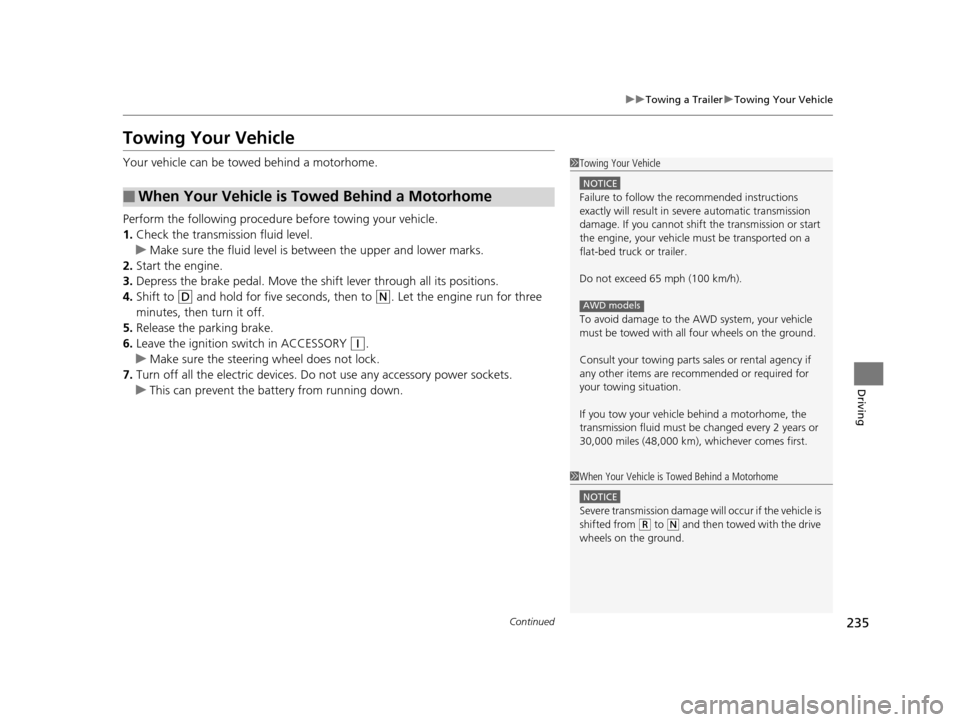
235
uuTowing a Trailer uTowing Your Vehicle
Continued
Driving
Towing Your Vehicle
Your vehicle can be towed behind a motorhome.
Perform the following procedure before towing your vehicle.
1. Check the transmission fluid level.
u Make sure the fluid level is be tween the upper and lower marks.
2. Start the engine.
3. Depress the brake pedal. Move the sh ift lever through all its positions.
4. Shift to
(D and hold for five seconds, then to (N. Let the engine run for three
minutes, then turn it off.
5. Release the parking brake.
6. Leave the ignition switch in ACCESSORY
(q.
u Make sure the steering wheel does not lock.
7. Turn off all the electric devices. Do not use any accessory power sockets.
u This can prevent the battery from running down.
■When Your Vehicle is Towed Behind a Motorhome
1Towing Your Vehicle
NOTICE
Failure to follow the recommended instructions
exactly will result in severe automatic transmission
damage. If you cannot shift the transmission or start
the engine, your vehicle must be transported on a
flat-bed truck or trailer.
Do not exceed 65 mph (100 km/h).
To avoid damage to the AWD system, your vehicle
must be towed with all four wheels on the ground.
Consult your towing parts sales or rental agency if
any other items are recommended or required for
your towing situation.
If you tow your vehicle behind a motorhome, the
transmission fluid must be changed every 2 years or
30,000 miles (48,000 km), whichever comes first.
AWD models
1 When Your Vehicle is Towed Behind a Motorhome
NOTICE
Severe transmission damage wi ll occur if the vehicle is
shifted from
( R to (N and then towed with the drive
wheels on the ground.
14 CR-V-31T0A6200.book 235 ページ 2014年2月10日 月曜日 午後7時1分
Page 242 of 365
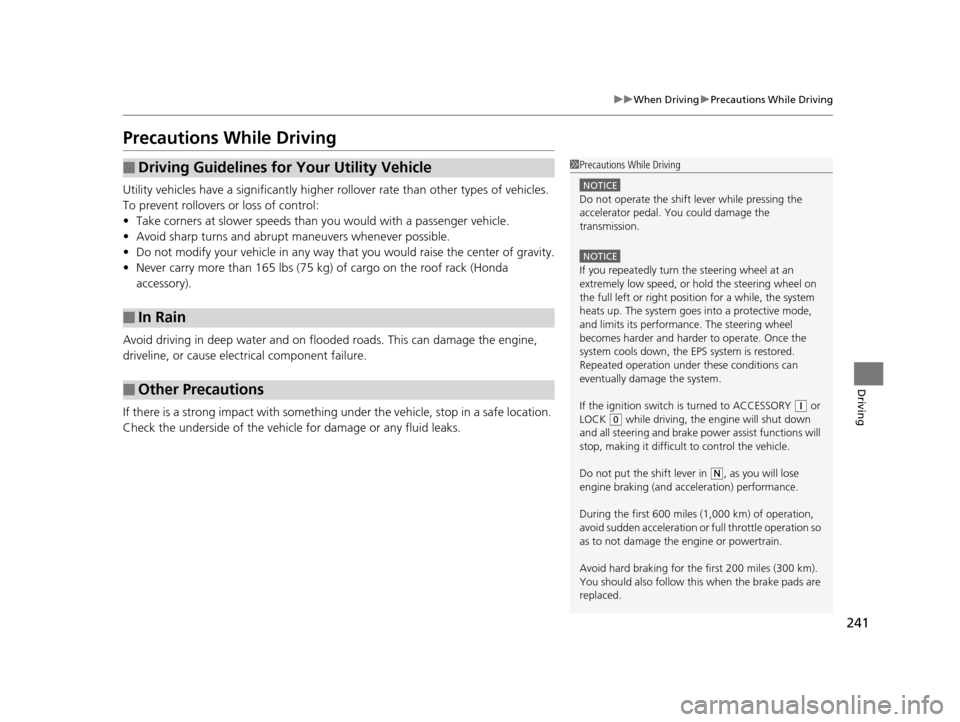
241
uuWhen Driving uPrecautions While Driving
Driving
Precautions While Driving
Utility vehicles have a significantly higher rollover rate than other types of vehicles.
To prevent rollovers or loss of control:
• Take corners at slower speeds than yo u would with a passenger vehicle.
• Avoid sharp turns and abrupt maneuvers whenever possible.
• Do not modify your vehicle in any way th at you would raise the center of gravity.
• Never carry more than 165 lbs (75 kg) of cargo on the roof rack (Honda
accessory).
Avoid driving in deep water and on flooded roads. This can damage the engine,
driveline, or cause electrical component failure.
If there is a strong impact with something under the vehicle, stop in a safe location.
Check the underside of the vehicle for damage or any fluid leaks.
■Driving Guidelines for Your Utility Vehicle
■In Rain
■Other Precautions
1 Precautions While Driving
NOTICE
Do not operate the shift lever while pressing the
accelerator pedal. You could damage the
transmission.
NOTICE
If you repeatedly turn the steering wheel at an
extremely low speed, or hold the steering wheel on
the full left or right position for a while, the system
heats up. The system goes into a protective mode,
and limits its performa nce. The steering wheel
becomes harder and harder to operate. Once the
system cools down, the EPS system is restored.
Repeated operation under these conditions can
eventually damage the system.
If the ignition switch is turned to ACCESSORY
( q or
LOCK
( 0 while driving, the e ngine will shut down
and all steering and brake pow er assist functions will
stop, making it difficult to control the vehicle.
Do not put the shift lever in
( N, as you will lose
engine braking (and acce leration) performance.
During the first 600 miles (1,000 km) of operation,
avoid sudden acceleration or full throttle operation so
as to not damage the engine or powertrain.
Avoid hard braking for the first 200 miles (300 km).
You should also follow this when the brake pads are
replaced.
14 CR-V-31T0A6200.book 241 ページ 2014年2月10日 月曜日 午後7時1分
Page 246 of 365
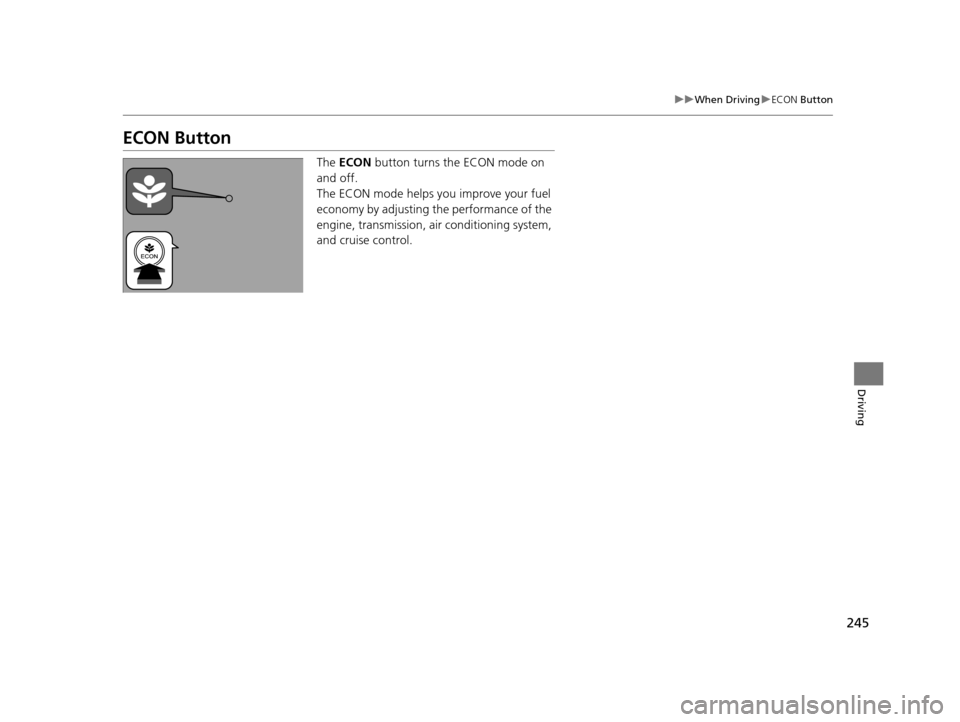
245
uuWhen Driving uECON Button
Driving
ECON Button
The ECON button turns the ECON mode on
and off.
The ECON mode helps you improve your fuel
economy by adjusting the performance of the
engine, transmission, air conditioning system,
and cruise control.
14 CR-V-31T0A6200.book 245 ページ 2014年2月10日 月曜日 午後7時1分
Page 247 of 365
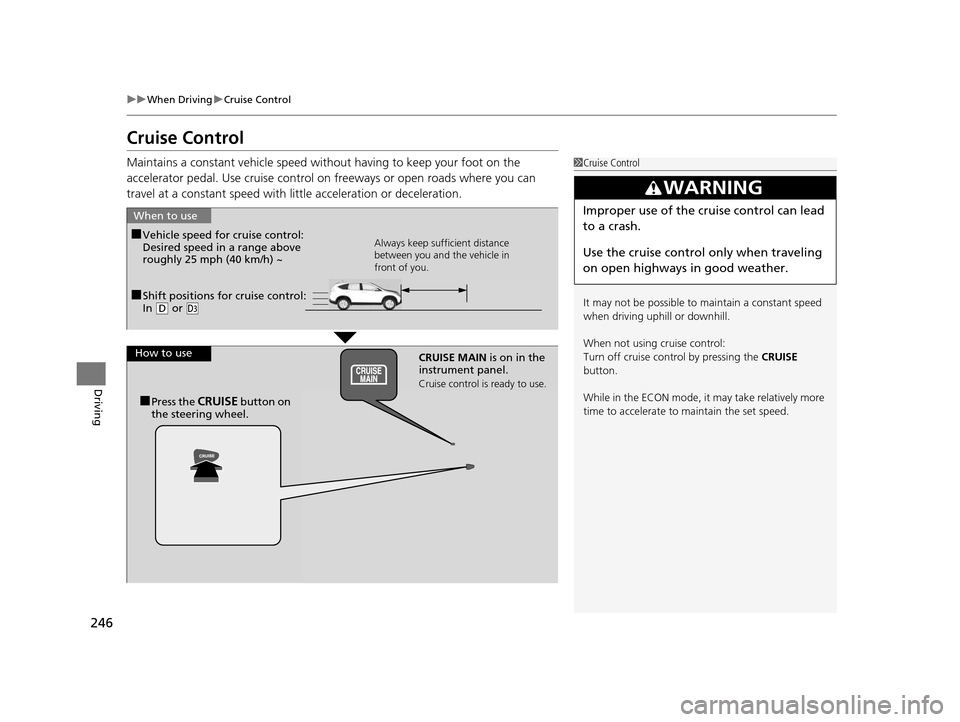
246
uuWhen Driving uCruise Control
Driving
Cruise Control
Maintains a constant vehicle speed without having to keep your foot on the
accelerator pedal. Use cruise control on freeways or open roads where you can
travel at a constant speed with little acceleration or deceleration.1 Cruise Control
It may not be possible to maintain a constant speed
when driving uphill or downhill.
When not using cruise control:
Turn off cruise control by pressing the CRUISE
button.
While in the ECON mode, it may take relatively more
time to accelerate to maintain the set speed.
3WARNING
Improper use of the cruise control can lead
to a crash.
Use the cruise control only when traveling
on open highways in good weather.
■Shift positions for cruise control:
In ( D or (d
When to use
Always keep sufficient distance
between you and the vehicle in
front of you.■Vehicle speed for cruise control:
Desired speed in a range above
roughly 25 mph (40 km/h) ~
How to use CRUISE MAIN is on in the
instrument panel.
Cruise control is ready to use.
■Press the CRUISE button on
the steering wheel.
14 CR-V-31T0A6200.book 246 ページ 2014年2月10日 月曜日 午後7時1分
Page 254 of 365
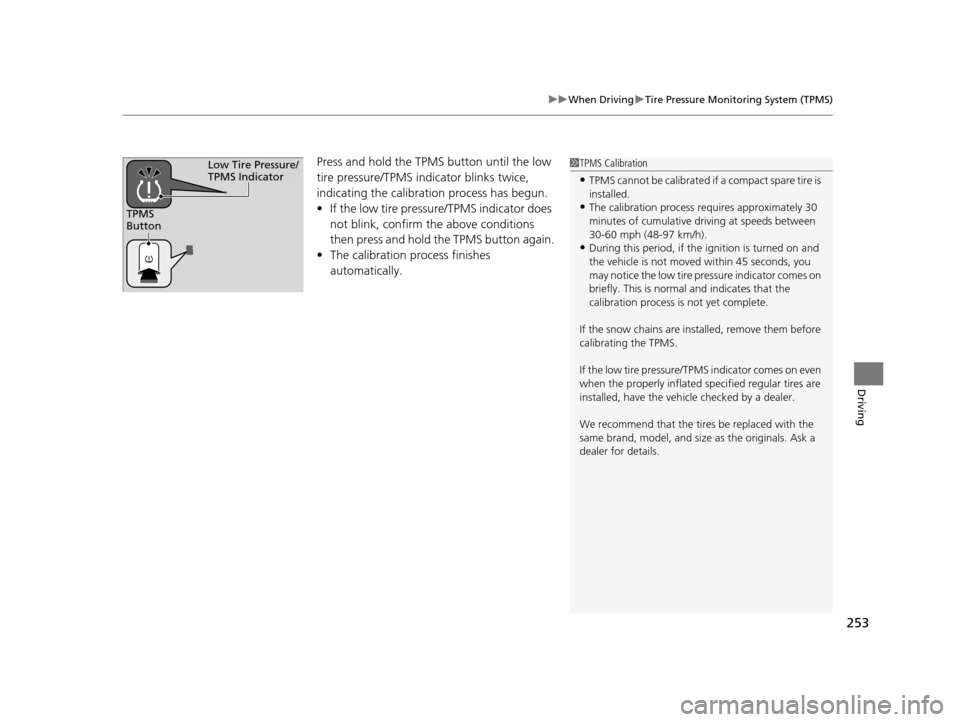
253
uuWhen Driving uTire Pressure Monitoring System (TPMS)
Driving
Press and hold the TPMS button until the low
tire pressure/TPMS indicator blinks twice,
indicating the calibration process has begun.
• If the low tire pressure/TPMS indicator does
not blink, confirm the above conditions
then press and hold the TPMS button again.
• The calibration process finishes
automatically.1TPMS Calibration
•TPMS cannot be calibrated if a compact spare tire is
installed.
•The calibration process requires approximately 30
minutes of cumulative dr iving at speeds between
30-60 mph (48-97 km/h).
•During this period, if the ignition is turned on and
the vehicle is not move d within 45 seconds, you
may notice the low tire pressure indicator comes on
briefly. This is normal and indicates that the
calibration process is not yet complete.
If the snow chains are installed, remove them before
calibrating the TPMS.
If the low tire pressure/TPMS indicator comes on even
when the properly inflated specified regular tires are
installed, have the vehi cle checked by a dealer.
We recommend that the tires be replaced with the
same brand, model, and size as the originals. Ask a
dealer for details.
TPMS
Button
Low Tire Pressure/
TPMS Indicator
14 CR-V-31T0A6200.book 253 ページ 2014年2月10日 月曜日 午後7時1分
Page 255 of 365
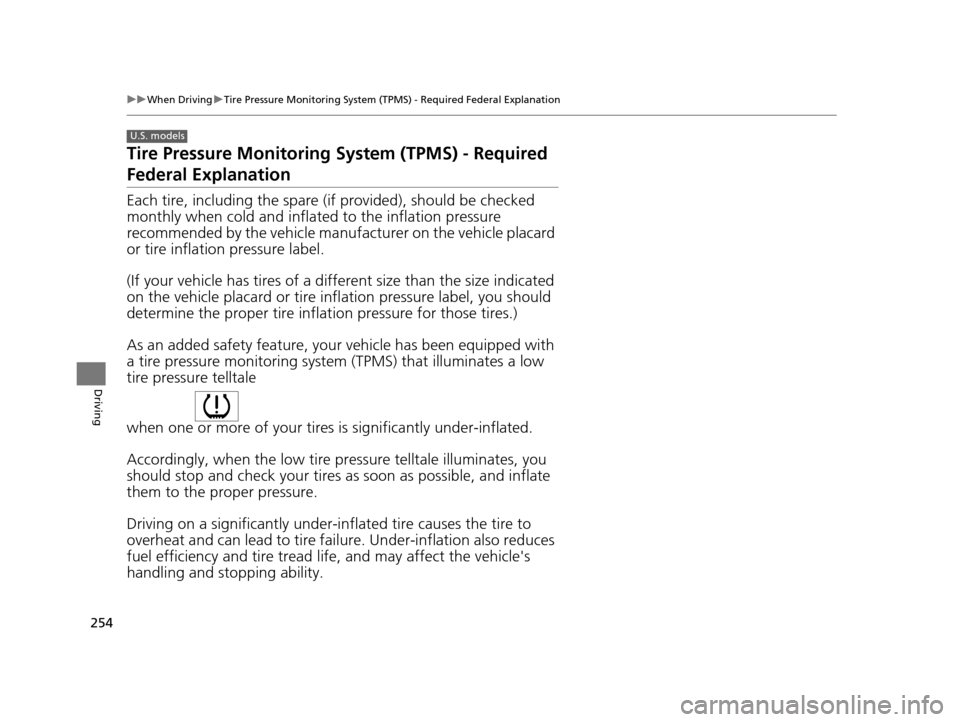
254
uuWhen Driving uTire Pressure Monitoring System (TPMS) - Required Federal Explanation
Driving
Tire Pressure Monitoring System (TPMS) - Required
Federal Explanation
Each tire, including the spare (i f provided), should be checked
monthly when cold and inflated to the inflation pressure
recommended by the vehicle manufacturer on the vehicle placard
or tire inflation pressure label.
(If your vehicle has tires of a different size than the size indicated
on the vehicle placard or tire infl ation pressure label, you should
determine the proper tire inflat ion pressure for those tires.)
As an added safety feature, your vehicle has been equipped with
a tire pressure monitoring system (TPMS) that illuminates a low
tire pressure telltale
when one or more of your tire s is significantly under-inflated.
Accordingly, when the low tire pr essure telltale illuminates, you
should stop and check your tires as soon as possible, and inflate
them to the proper pressure.
Driving on a significantly under-in flated tire causes the tire to
overheat and can lead to tire failure. Under-inflat ion also reduces
fuel efficiency and tire tread li fe, and may affect the vehicle's
handling and stopping ability.
U.S. models
14 CR-V-31T0A6200.book 254 ページ 2014年2月10日 月曜日 午後7時1分
Page 268 of 365
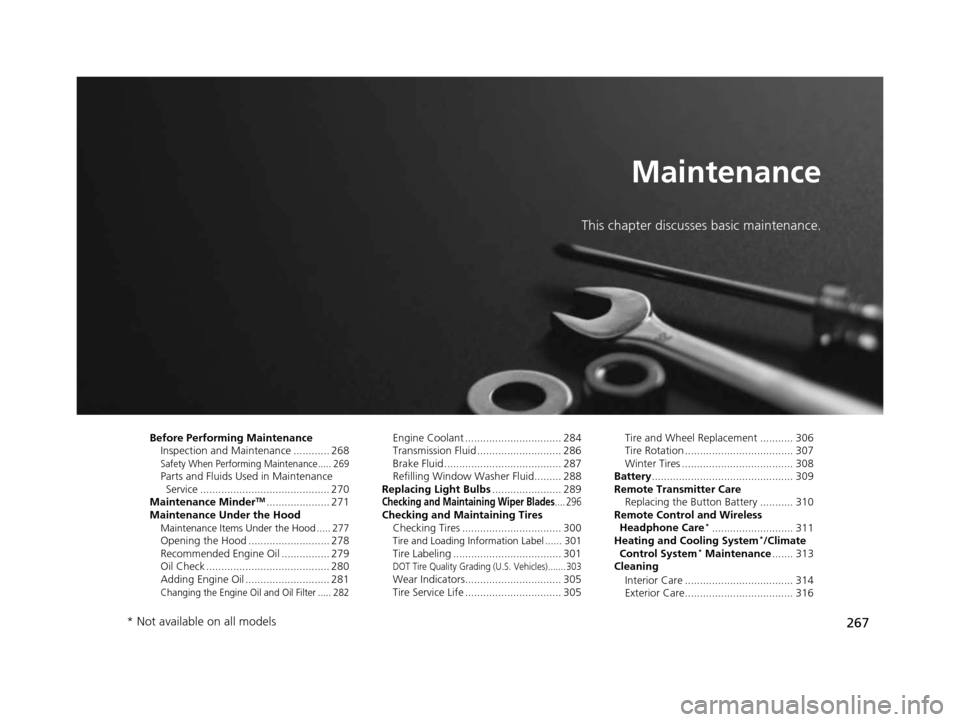
267
Maintenance
This chapter discusses basic maintenance.
Before Performing MaintenanceInspection and Maintenance ............ 268
Safety When Performing Maintenance..... 269Parts and Fluids Used in Maintenance Service ........................................... 270
Maintenance Minder
TM..................... 271
Maintenance Under the Hood
Maintenance Items Under the Hood ..... 277Opening the Hood ........................... 278
Recommended Engine Oil ................ 279
Oil Check ......................................... 280
Adding Engine Oil ............................ 281
Changing the Engine Oil and Oil Filter ..... 282
Engine Coolant ................................ 284
Transmission Fluid ............................ 286
Brake Fluid ....................................... 287
Refilling Window Wa sher Fluid......... 288
Replacing Light Bulbs ....................... 289
Checking and Maintaining Wiper Blades.... 296Checking and Maintaining Tires
Checking Tires ................................. 300
Tire and Loading Information Label ...... 301Tire Labeling .................................... 301DOT Tire Quality Grading (U.S. Vehicles)....... 303Wear Indicators................................ 305
Tire Service Life ................................ 305 Tire and Wheel Replacement ........... 306
Tire Rotation .................................... 307
Winter Tires ..................................... 308
Battery ............................................... 309
Remote Transmitter Care Replacing the Button Battery ........... 310
Remote Control and Wireless Headphone Care
*........................... 311
Heating and Cooling System*/Climate
Control System* Maintenance ....... 313
Cleaning
Interior Care .................................... 314
Exterior Care.................................... 316
* Not available on all models
14 CR-V-31T0A6200.book 267 ページ 2014年2月10日 月曜日 午後7時1分
Page 269 of 365
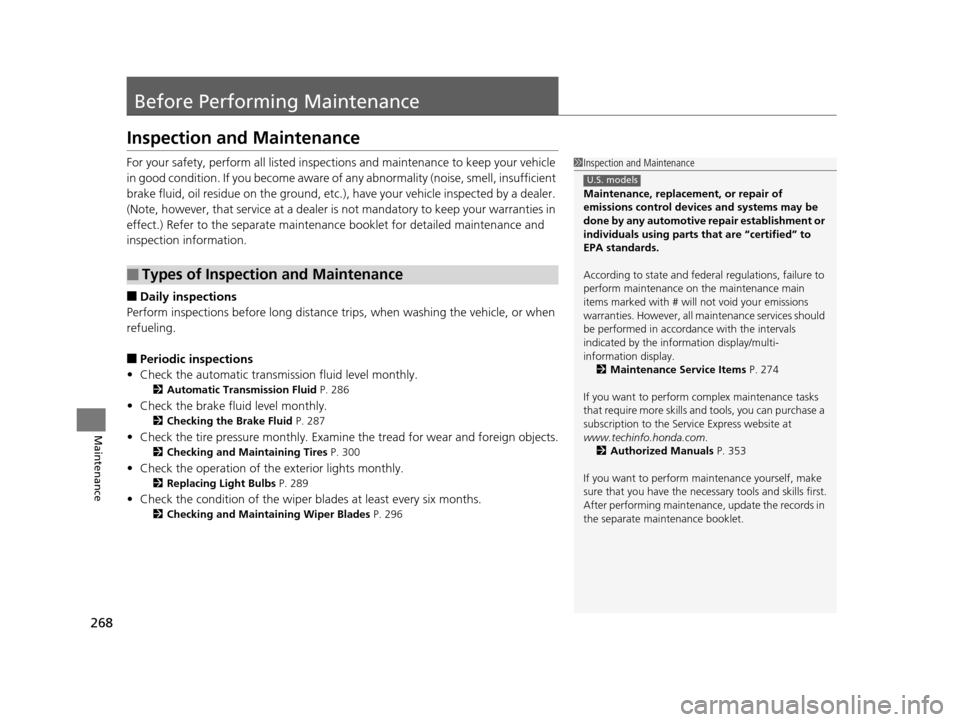
268
Maintenance
Before Performing Maintenance
Inspection and Maintenance
For your safety, perform all listed inspections and maintenance to keep your vehicle
in good condition. If you become aware of any abnormality (noise, smell, insufficient
brake fluid, oil residue on the ground, etc.), have your vehicle inspected by a dealer.
(Note, however, that service at a dealer is not mandatory to keep your warranties in
effect.) Refer to the separate maintena nce booklet for detailed maintenance and
inspection information.
■Daily inspections
Perform inspections before long distance tri ps, when washing the vehicle, or when
refueling.
■Periodic inspections
• Check the automatic transmi ssion fluid level monthly.
2Automatic Transmission Fluid P. 286
•Check the brake fluid level monthly.
2 Checking the Brake Fluid P. 287
•Check the tire pressure monthly. Examin e the tread for wear and foreign objects.
2Checking and Maintaining Tires P. 300
•Check the operation of the exterior lights monthly.
2 Replacing Light Bulbs P. 289
•Check the condition of the wiper bl ades at least every six months.
2Checking and Maintaining Wiper Blades P. 296
■Types of Inspection and Maintenance
1Inspection and Maintenance
Maintenance, replacement, or repair of
emissions control devices and systems may be
done by any automotive repair establishment or
individuals using parts that are “certified” to
EPA standards.
According to state and fede ral regulations, failure to
perform maintenance on the maintenance main
items marked with # will not void your emissions
warranties. However, all ma intenance services should
be performed in accordan ce with the intervals
indicated by the information display/multi-
information display.
2 Maintenance Service Items P. 274
If you want to perform complex maintenance tasks
that require more skills a nd tools, you can purchase a
subscription to the Service Express website at
www.techinfo.honda.com .
2 Authorized Manuals P. 353
If you want to perform ma intenance yourself, make
sure that you have the necessary tools and skills first.
After performing ma intenance, update the records in
the separate maintenance booklet.
U.S. models
14 CR-V-31T0A6200.book 268 ページ 2014年2月10日 月曜日 午後7時1分
Page 274 of 365
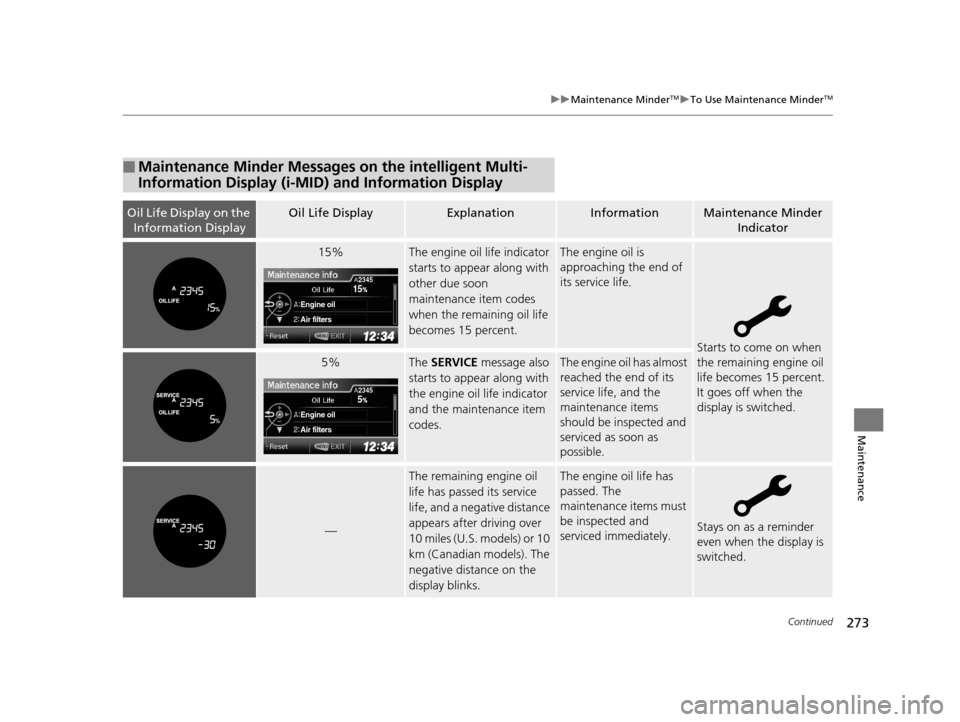
273
uuMaintenance MinderTMuTo Use Maintenance MinderTM
Continued
Maintenance
■Maintenance Minder Messages on the intelligent Multi-
Information Display (i-MID) and Information Display
Oil Life Display on the
Information DisplayOil Life DisplayExplanationInformationMaintenance Minder Indicator
15%The engine oil life indicator
starts to appear along with
other due soon
maintenance item codes
when the remaining oil life
becomes 15 percent.The engine oil is
approaching the end of
its service life.
Starts to come on when
the remaining engine oil
life becomes 15 percent.
It goes off when the
display is switched.
5%The SERVICE message also
starts to appear along with
the engine oil life indicator
and the maintenance item
codes.The engine oil has almost
reached the end of its
service life, and the
maintenance items
should be inspected and
serviced as soon as
possible.
—
The remaining engine oil
life has passed its service
life, and a negative distance
appears after driving over
10 miles (U.S. models) or 10
km (Canadian models). The
negative distance on the
display blinks.The engine oil life has
passed. The
maintenance items must
be inspected and
serviced immediately.
Stays on as a reminder
even when the display is
switched.
15
Engine oil
Air filters
2345
5
Engine oil
Air filters
2345
14 CR-V-31T0A6200.book 273 ページ 2014年2月10日 月曜日 午後7時1分
Page 307 of 365
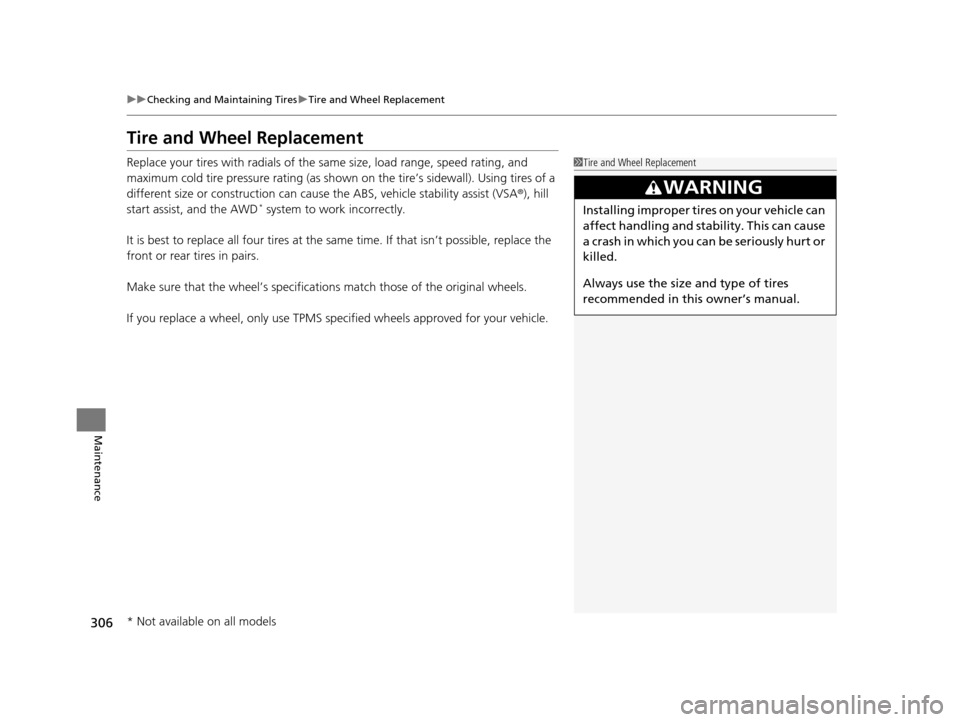
306
uuChecking and Maintaining Tires uTire and Wheel Replacement
Maintenance
Tire and Wheel Replacement
Replace your tires with radials of the sa me size, load range, speed rating, and
maximum cold tire pressure ra ting (as shown on the tire’s sidewall). Using tires of a
different size or construction can cause the ABS, vehicle stability assist (VSA ®), hill
start assist, and the AWD
* system to work incorrectly.
It is best to replace all four tires at the same time. If that isn’t possible, replace the
front or rear tires in pairs.
Make sure that the wheel’s specifications match thos e of the original wheels.
If you replace a wheel, only use TPMS sp ecified wheels approved for your vehicle.
1Tire and Wheel Replacement
3WARNING
Installing improper tires on your vehicle can
affect handling and stability. This can cause
a crash in which you can be seriously hurt or
killed.
Always use the size and type of tires
recommended in this owner’s manual.
* Not available on all models
14 CR-V-31T0A6200.book 306 ページ 2014年2月10日 月曜日 午後7時1分